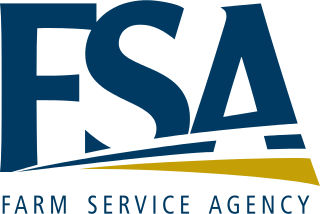
The Great Society was a set of domestic programs in the United States launched by President Lyndon B. Johnson in 1964 and 1965. The term was first referenced during a 1964 speech by Johnson at Ohio University, then later formally presented at the University of Michigan, and came to represent his domestic agenda. The main goal was the total elimination of poverty and racial injustice.

The United States Department of Agriculture (USDA) is the federal executive department responsible for developing and executing federal laws related to farming, forestry, rural economic development, and food. It aims to meet the needs of commercial farming and livestock food production, promotes agricultural trade and production, works to assure food safety, protects natural resources, fosters rural communities and works to end hunger in the United States and internationally. It is headed by the secretary of agriculture, who reports directly to the president of the United States and is a member of the president's Cabinet. The current secretary is Tom Vilsack, who has served since February 24, 2021.

The Farm Service Agency (FSA) is the United States Department of Agriculture agency that was formed by merging the farm loan portfolio and staff of the Farmers Home Administration (FmHA) and the Agricultural Stabilization and Conservation Service (ASCS). The Farm Service Agency implements agricultural policy, administers credit and loan programs, and manages conservation, commodity, disaster, and farm marketing programs through a national network of offices. The Administrator of FSA reports to the Under Secretary of Agriculture for Farm Production and Conservation. The current administrator is Zach Ducheneaux. The FSA of each state is led by a politically appointed State Executive Director (SED).
The term New Frontier was used by Democratic presidential candidate John F. Kennedy in his acceptance speech in the 1960 United States presidential election to the Democratic National Convention at the Los Angeles Memorial Coliseum as the Democratic slogan to inspire America to support him. The phrase developed into a label for his administration's domestic and foreign programs.
The Commodity Credit Corporation (CCC) is a wholly owned United States government corporation that was created in 1933 to "stabilize, support, and protect farm income and prices". The CCC is authorized to buy, sell, lend, make payments, and engage in other activities for the purpose of increasing production, stabilizing prices, assuring adequate supplies, and facilitating the efficient marketing of agricultural commodities.
The Farm Credit System (FCS) in the United States is a nationwide network of borrower-owned lending institutions and specialized service organizations. The Farm Credit System provides more than $343 billion in loans, leases, and related services to farmers, ranchers, rural homeowners, aquatic producers, timber harvesters, agribusinesses, and agricultural and rural utility cooperatives.

The Foreign Assistance Act is a United States law governing foreign aid policy. It outlined the political and ideological principles of U.S. foreign aid, significantly overhauled and reorganized the structure U.S. foreign assistance programs, legally distinguished military from nonmilitary aid, and created a new agency, the United States Agency for International Development (USAID) to administer nonmilitary economic assistance programs. Following its enactment by Congress on September 4, 1961, President John F. Kennedy signed the Act into law on November 3, 1961, issuing Executive Order 10973 detailing the reorganization.

The Federal Agriculture Improvement and Reform Act of 1996, known informally as the Freedom to Farm Act, the FAIR Act, or the 1996 U.S. Farm Bill, was the omnibus 1996 farm bill that, among other provisions, revises and simplifies direct payment programs for crops and eliminates milk price supports through direct government purchases.
In different administrative and organizational forms, the Food for Peace program of the United States has provided food assistance around the world for more than 60 years. Approximately 3 billion people in 150 countries have benefited directly from U.S. food assistance. The Bureau for Humanitarian Assistance within the United States Agency for International Development (USAID) is the U.S. Government's largest provider of overseas food assistance. The food assistance programming is funded primarily through the Food for Peace Act. The Bureau for Humanitarian Assistance also receives International Disaster Assistance Funds through the Foreign Assistance Act (FAA) that can be used in emergency settings.

USDA Rural Development (RD) is a mission area within the United States Department of Agriculture which runs programs intended to improve the economy and quality of life in rural parts of the United States.

The Food, Conservation, and Energy Act of 2008 was a $288 billion, five-year agricultural policy bill that was passed into law by the United States Congress on June 18, 2008. The bill was a continuation of the 2002 Farm Bill. It continues the United States' long history of agricultural subsidies as well as pursuing areas such as energy, conservation, nutrition, and rural development. Some specific initiatives in the bill include increases in Food Stamp benefits, increased support for the production of cellulosic ethanol, and money for the research of pests, diseases and other agricultural problems.
The agricultural policy of the United States is composed primarily of the periodically renewed federal U.S. farm bills. The Farm Bills have a rich history which initially sought to provide income and price support to US farmers and prevent them from adverse global as well as local supply and demand shocks. This implied an elaborate subsidy program which supports domestic production by either direct payments or through price support measures. The former incentivizes farmers to grow certain crops which are eligible for such payments through environmentally conscientious practices of farming. The latter protects farmers from vagaries of price fluctuations by ensuring a minimum price and fulfilling their shortfalls in revenue upon a fall in price. Lately, there are other measures through which the government encourages crop insurance and pays part of the premium for such insurance against various unanticipated outcomes in agriculture.

In United States federal agriculture legislation, the Agricultural Credit Act of 1987 was enacted in response to the severe financial crisis of the early- to mid-1980s, which affected both farmers and their lending institutions.

The Agriculture and Consumer Protection Act of 1973 was the 4-year farm bill that adopted target prices and deficiency payments as a tool that would support farm income but reduce forfeitures to the Commodity Credit Corporation (CCC) of surplus stocks. It reduced payment limitations to $20,000 for all program crops. The Act might be considered the first omnibus farm bill because it went beyond simply authorizing farm commodity programs. It authorized disaster payments and disaster reserve inventories; created the Rural Environmental Conservation Program; amended the Food Stamp Act of 1964, authorized the use of commodities for feeding low income mothers and young children (the origin of the Commodity Supplemental Food Program; and amended the Consolidated Farm and Rural Development Act of 1972.

The Consolidated Farm and Rural Development Act of 1972 or Con Act authorized a major expansion of USDA lending activities, which at the time were administered by Farmers Home Administration (FmHA). The legislation was originally enacted as the Consolidated Farmers Home Administration Act of 1961. In 1972, this title was changed to the Consolidated Farm and Rural Development Act, and is often referred to as the Con Act.

The Food, Agriculture, Conservation, and Trade (FACT) Act of 1990 — P.L. 101-624 was a 5-year omnibus farm bill that passed Congress and was signed into law.

The Federal Crop Insurance Reform and Department of Agriculture Reorganization Act of 1994, Pub. L.Tooltip Public Law 103–354, 108 Stat. 3178, was introduced on April 14, 1994 by Eligio de la Garza (D-TX) and was signed into law on October 13, 1994 by President William J. Clinton. It consisted of two titles:

The United States Food and Agriculture Act of 1977 was an omnibus farm bill. The S. 275 legislation was passed by the 95th U.S. Congressional session and signed into law by the 39th President of the United States Jimmy Carter on September 29, 1977.
The Consolidated Farm and Rural Development Act, authorizes the Farm Service Agency to make direct and guaranteed farm ownership loans to eligible family farmers.
The Consolidated Farm and Rural Development Act, authorizes the Farm Service Agency (FSA) to make direct and guaranteed farm operating loans.









